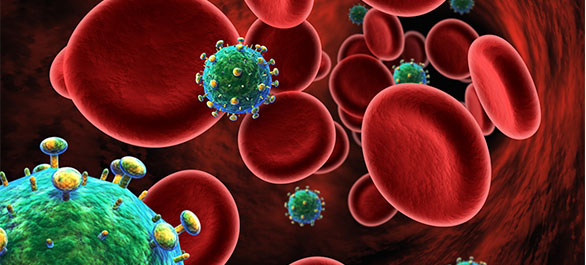
การจัดการภาวะแทรกซ้อนยาต้านรีโทรไวรัส ตอน 10
- โดย ภก.วิชญ์ภัทร ธรานนท์
- 15 ตุลาคม 2561
- Tweet

สาเหตุ
ยากลุ่มเอ็นอาร์ทีไอ (NRTIs) ที่กดการทำงานของไขกระดูกได้บ่อย คือ ซิโดวูดีน (zidovudine; AZT) ทำให้เกิดภาวะซีด (ร้อยละ 1.1 – 4.0) และเม็ดเลือดขาวต่ำ (ร้อยละ 1.8 – 8.0) มักพบหลังจากเริ่มยาประมาณ 2 – 3 สัปดาห์แรกจนถึงหลายเดือนหรือเป็นปี การเกิดเม็ดเลือดขาวต่ำ มักใช้ระยะเวลานานกว่าการเกิดโลหิตจาง
กลไกการเกิดโลหิตจางเป็นจากการขาด thymidine triphosphate ซึ่งยับยั้งการเจริญเติบโตของตัวอ่อน (stem cell maturation) ในการสร้างเม็ดเลือด ผู้ที่มีอาการซีดและอ่อนเพลีย ถ้ามีเม็ดเลือดขาวต่ำก็มีโอกาสเกิดการติดเชื้อได้ง่าย
ผู้ป่วยที่อยู่ในระยะท้ายของการติดเชื้อเอชไอวี ได้รับยาซิโดวูดีนขนาดสูง หรือไม่เหมาะสมกับน้ำหนักตัว หรือได้ยามาเป็นระยะเวลานาน อาจมีภาวะโลหิตจาง หรือภาวะเม็ดเลือดขาวต่ำ ถือว่าเป็นปัจจัยเสี่ยงของการกดการทำงานของไขกระดูก หรือผู้ป่วยได้รับยาอื่นที่กดการทำงานของไขกระดูกร่วมด้วย เช่น trimethoprim/sulfamethoxazole, ribavirin, ganciclovir
การป้องกัน
หลีกเลี่ยงการใช้ยาซิโดวูดีน (ZDV) และหรือเลี่ยงการใช้ยาอื่นๆที่มีผลกดการทำงานของไขกระดูกร่วมด้วย โดยเฉพาะผู้ที่มีปัจจัยเสี่ยงดังที่กล่าวมา ในกรณีที่จำเป็นต้องใช้ยา ZDV หลังจากเริ่มใช้ยาแล้ว ควรตรวจความสมบูรณ์ของเลือดอย่างน้อยทุก 3-6 เดือน แต่ถ้าผู้ที่มีความเสี่ยงหรือมีความผิดปกติของความสมบูรณ์ของเลือดอยู่ก่อนอาจตรวจด้วยความถี่มากยิ่งขึ้น โดยควรเลือกขนาดยาให้เหมาะสมกับน้ำหนักของผู้ติดเชื้อแต่ละราย ขนาดยา ZDV ที่แนะนำให้ใช้ได้มีตั้งแต่ 400 มิลลิกรัม – 600 มิลลิกรัมต่อวัน หากผู้ป่วยมีน้ำหนักน้อย 40 กิโลกรัม การให้ ZDV 400 มิลลิกรัมต่อวัน แบ่งให้ทุก 12 ชั่วโมงก็เพียงพอ
สำหรับผู้ป่วยที่กำลังใช้ยาซิโดวูดีนอยู่ แล้วเกิดอาการปกติขึ้น เช่น รู้สึกอ่อนเพลียผิดปกติ มีภาวะซีด ไม่มีแรง ควรรีบปรึกษาแพทย์ทันที
การรักษา
ปรับเปลี่ยนยา ZDV ไปเป็นยาในกลุ่ม NRTIs ชนิดอื่น ถ้าไม่มีข้อจำกัดและข้อห้าม รวมถึงหยุดหรือเปลี่ยนยาอื่นที่กดการทำงานของไขกระดูกที่ได้รับร่วมด้วย บางครั้งถ้ามีเม็ดเลือดขาวต่ำไม่มาก (3,000-4,000 เซลล์/ลูกบาศ์กมิลลิเมตร) อาจติดตามจำนวนเม็ดเลือดขาวซ้ำอีก 2 – 3 เดือน เนื่องจากเม็ดเลือดขาวอาจกลับมาเป็นปกติโดยยังไม่ต้องเปลี่ยนยา เพราะวันที่เจาะเลือด ผู้ป่วยอาจจะมีการติดเชื้อไวรัสอื่น หรือสาเหตุอื่นๆที่ทำให้มีเม็ดเลือดขาวต่ำได้ชั่วคราว การรักษาหากมีจำนวน นิวโทรฟิลน้อยกว่า 750 – 1000 เซลล์/ลูกบาศ์กมิลลิเมตร คือ ให้ยากระตุ้นการสร้างเม็ดเลือดขาว ในกรณีที่มีภาวะซีดมากอาจจะต้องให้เลือดโดยเฉพาะถ้ามีอาการเหนื่อยหรือเพลีย หรืออาจจะต้องให้ยากลุ่มกระตุ้นการทำงานของเลือด เช่น อิลิโทรโพยอิติน (erythropoietin) และพิจารณาให้กรดโฟลิก (folic acid) เสริมจะช่วยลดอาการซีดให้มีอาการดีขึ้น
บรรณานุกรม:
- Department of disease control, Thailand National Guidelines on HIV/AIDS Treatment and Prevention 2017. availavle from http://www.thaiaidssociety.org/images/PDF/ hiv_thai_guideline _2560.pdf.
- Cohen DE, Mayer KH. Primary care issues for HIV-infected patients. Infect Dis Clin N Am 21 (2007): 49–70.
- วีรวัฒน์ มโนสุทธิ. Current management of complication of antiretroviral therapy. ใน: ชาญกิจ พุฒิเลอพงศ์, ณัฏฐดา อารีเปี่ยม, แสง อุษยาพร, บรรณาธิการ. Pharmacotherapy in infectious disease VII. กรุงเทพมหานคร. สำนักพิมพ์แห่งจุฬาลงกรณ์มหาวิทยาลัย. 2558, หน้า 198-201.
- Group TISS. Initiation of Antiretroviral Therapy in Early Asymptomatic HIV Infection. New England Journal of Medicine. 2015;373(9):795-807.
- Group TTAS. A Trial of Early Antiretrovirals and Isoniazid Preventive Therapy in Africa. New England Journal of Medicine. 2015;373(9):808-22.
- Ayoko R. Bossou SC, Karen K. O’Brien, Catherine A. Opere, Christopher J. Destache. Preventive HIV Vaccines: Progress and Challenges. US Pharmacist. 2015 OCTOBER 16, 2015:46-50.
- รัชนู เจริญพักตร์ และ ชาญกิจ พุฒิเลอพงศ์. Current update on HIV/AIDs treatment guideline in 2017. ใน: ชาญกิจ พุฒิเลอพงศ์, โชติรัตน์ นครานุรักษ์, และ แสง อุษยาพร, บรรณาธิการ. Pharmacotherapy in infectious disease IX. กรุงเทพมหานคร. สำนักพิมพ์แห่งจุฬาลงกรณ์มหาวิทยาลัย. 2560, หน้า 342-364.
- Wada N JL, Cohen M, French A, Phair J, Munoz A. Cause-specific life expectancies after 35 years of age for human immunodeficiency syndrome-infected and human immunodeficiency syndrome-negative individuals followed simultaneously in long-term cohort studies, 1984-2008. Am J Epidermol. 2013; 177: 116-125.
- Department of Health and Human Services. Guidelines for the Use of Antiretroviral Agents in Adults and Adolescents Living with HIV Available from: https://aidsinfo.nih.gov/guidelines.
- O'Brien ME, Clark RA, Besch CL, Myers L, Kissinger P. Patterns and correlates of discontinuation of the initial HAART regimen in an urban outpatient cohort. Journal of acquired immune deficiency syndromes (1999). 2003;34(4):407-14.
- Kiertiburanakul S, Luengroongroj P, Sungkanuparph S. Clinical characteristics of HIV-infected patients who survive after the diagnosis of HIV infection for more than 10 years in a resource-limited setting. Journal of the International Association of Physicians in AIDS Care (Chicago, Ill : 2002). 2012;11(6):361-5.
- Wiboonchutikul S, Sungkanuparph S, Kiertiburanakul S, Chailurkit LO, Charoenyingwattana A, Wangsomboonsiri W, et al. Vitamin D insufficiency and deficiency among HIV-1-infected patients in a tropical setting. Journal of the International Association of Physicians in AIDS Care (Chicago, Ill : 2002). 2012;11(5):305-10.
- Wilde JT, Lee CA, Collins P, Giangrande PL, Winter M, Shiach CR. Increased bleeding associated with protease inhibitor therapy in HIV-positive patients with bleeding disorders. British journal of haematology. 1999;107(3):556-9.
- European AIDS Clinical Society. EACS Guidelines version 8.1-October 2016. Available from http://www.eacsociety.org/files/guidelines_8.1-english.pdf.
- ศศิโสภิณ เกียรติบูรณกุล. การดูแลรักษาผู้ติดเชื้อเอชไอวีแบบผู้ป่วยนอก.กรุงเทพฯ : ภาควิชาอายุรศาสตร์ คณะแพทยศาตร์โรงพยาบาลรามาธิบดี มหาวิทยาลัยมหิดล, 2557
- Morse CG, Mican JM, Jones EC, Joe GO, Rick ME, Formentini E, et al. The incidence and natural history of osteonecrosis in HIV-infected adults. Clinical infectious diseases : an official publication of the Infectious Diseases Society of America. 2007;44(5):739-48.
- Woodward CL, Hall AM, Williams IG, Madge S, Copas A, Nair D, et al. Tenofovir-associated renal and bone toxicity. HIV medicine. 2009;10(8):482-7.
- Wang H, Lu X, Yang X, Xu N. The efficacy and safety of tenofovir alafenamide versus tenofovir disoproxil fumarate in antiretroviral regimens for HIV-1 therapy: Meta-analysis. Medicine. 2016;95(41):e5146.
- Redig AJ, Berliner N. Pathogenesis and clinical implications of HIV-related anemia in 2013. Hematology American Society of Hematology Education Program. 2013;2013:377-81.
- Assefa M, Abegaz WE, Shewamare A, Medhin G, Belay M. Prevalence and correlates of anemia among HIV infected patients on highly active anti-retroviral therapy at Zewditu Memorial Hospital, Ethiopia. BMC Hematology. 2015;15:6.
- de Gaetano Donati K, Cauda R, Iacoviello L. HIV Infection, Antiretroviral Therapy and Cardiovascular Risk. Mediterranean Journal of Hematology and Infectious Diseases. 2010;2(3):e2010034.
- Group TDS. Class of Antiretroviral Drugs and the Risk of Myocardial Infarction. New England Journal of Medicine. 2007;356(17):1723-35.
- Tsiodras S, Mantzoros C, Hammer S, Samore M. Effects of protease inhibitors on hyperglycemia, hyperlipidemia, and lipodystrophy: a 5-year cohort study. Archives of internal medicine. 2000;160(13):2050-6.
- วราภณ วงศ์ถาวราวัฒน์. Diagnosis and classification of Diabetes Mellitus. ใน: ธิติ สนับบุญ, บรรณาธิการ. แนวทางเวชปฏิบัติทางต่อมไร้ท่อ. กรุงเทพมหานคร.โรงพิมพ์แห่งจุฬาลงกรณ์มหาวิทยาลัย. 2560, หน้า 1-9.
- ชาญกิจ พุฒิเลอพงศ์. Clinical management for dyslipidemia in HIV-infected patients. ใน: ชาญกิจ พุฒิเลอพงศ์ และ ณัฏฐดา อารีเปี่ยม, บรรณาธิการ. Pharmacotherapy in infectious disease VI. กรุงเทพมหานคร. คอนเซ็พท์พริ้นท์. 2557, หน้า 198-201.
- Dube MP, Stein JH, Aberg JA, Fichtenbaum CJ, Gerber JG, Tashima KT, et al. Guidelines for the evaluation and management of dyslipidemia in human immunodeficiency virus (HIV)-infected adults receiving antiretroviral therapy: recommendations of the HIV Medical Association of the Infectious Disease Society of America and the Adult AIDS Clinical Trials Group. Clinical infectious diseases : an official publication of the Infectious Diseases Society of America. 2003;37(5):613-27.
- Hoffman RM, Currier JS. Management of antiretroviral treatment-related complications. Infectious disease clinics of North America. 2007;21(1):103-32, ix.
- Husain NEOS, Ahmed MH. Managing dyslipidemia in HIV/AIDS patients: challenges and solutions. HIV/AIDS (Auckland, NZ). 2015;7:1-10.
- Kiertiburanakul S, Sungkanuparph S, Charoenyingwattana A, Mahasirimongkol S, Sura T, Chantratita W. Risk factors for nevirapine-associated rash among HIV-infected patients with low CD4 cell counts in resource-limited settings. Current HIV research. 2008;6(1):65-9.
- Murphy RL. Defining the toxicity profile of nevirapine and other antiretroviral drugs. Journal of acquired immune deficiency syndromes (1999). 2003;34 Suppl 1:S15-20.
- Department of Health and Human Services. HIV and Lactic Acidosis. Available from: https://aidsinfo.nih.gov/understanding-hiv-aids/fact-sheets/22/68/hiv-and-lactic-acidosis.
- Grinspoon S, Carr A. Cardiovascular Risk and Body-Fat Abnormalities in HIV-Infected Adults. New England Journal of Medicine. 2005;352(1):48-62.
- Simpson D, Estanislao L, Evans S , McArthur J, Marcusd K, Truffa M et,al. HIV-associated neuromuscular weakness syndrome. AIDS (London, England). 2004;18(10):1403-12.
- Hall AM, Hendry BM, Nitsch D, Connolly JO. Tenofovir-associated kidney toxicity in HIV-infected patients: a review of the evidence. American journal of kidney diseases : the official journal of the National Kidney Foundation. 2011;57(5):773-80.
- Chaisiri K, Bowonwatanuwong C, Kasettratat N, Kiertiburanakul S. Incidence and risk factors for tenofovir-associated renal function decline among Thai HIV-infected patients with low-body weight. Current HIV research. 2010;8(7):504-9.
- Schwarzwald H, Gillespie S. Management of Antiretroviral-Associated Complications. Available from: https://bipai.org/sites/bipai/files/5-Mgt-assoc-complications.pdf
- ศศิโสภิณ เกียรติบูรณกุล. Practical management of complication-associated with ARVใน: นารัต เกษตรทัต, ชาญกิจ พุฒิเลอพงศ์ และ ณัฏฐดา อารีเปี่ยม, บรรณาธิการ. Pharmacotherapy in infectious disease VI. กรุงเทพมหานคร. คอนเซ็พท์พริ้นท์. 2554, หน้า 317-346.


